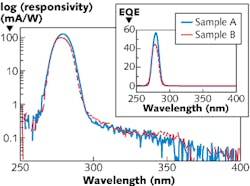Stress-reduced solar-blind AlGaN-based FPA is crack-free
Focal-plane arrays (FPAs) that operate in the solar-blind spectral region (created by the absorption of light below 290 nm by atmospheric ozone) have uses in covert non-line-of-sight and other forms of free-space communications, as well as UV spectroscopy, flame detection, and many other applications. With their extremely high rejection of the non-solar-blind spectrum, aluminum gallium nitride (AlGaN)-based structures are potentially excellent photodetecting candidates for solar-blind FPAs. However, this type of structure is difficult to fabricate without the formation of cracks. Manijeh Razeghi’s group at Northwestern University (Evanston, IL) has developed a solution to this problem by patterning an AlN template into isolated mesas that help reduce cracks in the AlGaN-based structure that is then grown.
Square mesas 26 μm on a side are etched partway into the AlN in a 2D square array with a 30 μm period by etching the AlN to a 300 nm depth that separates the mesas so that stress in one does not affect others, but is not so deep that lateral conductivity suffers. The rest of the FPA is then fabricated, ensuring that the conduction layer is continuous between mesas. At a 279 nm wavelength, two FPA samples had external quantum efficiencies (EQEs) of 38% and 27%, respectively, and responsivities of 86.2 and 60.9 mA/W, respectively, for zero bias; and 57% and 44%, respectively, and 129.4 mA/W and 99.4 mA/W, respectively, for 5 V reverse bias. Contact Manijeh Razeghi at [email protected].
About the Author
John Wallace
Senior Technical Editor (1998-2022)
John Wallace was with Laser Focus World for nearly 25 years, retiring in late June 2022. He obtained a bachelor's degree in mechanical engineering and physics at Rutgers University and a master's in optical engineering at the University of Rochester. Before becoming an editor, John worked as an engineer at RCA, Exxon, Eastman Kodak, and GCA Corporation.

